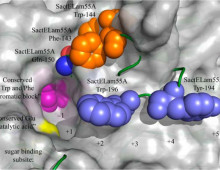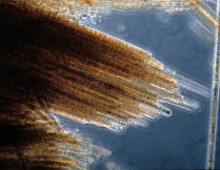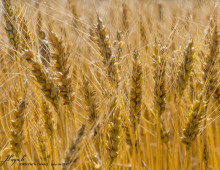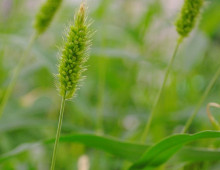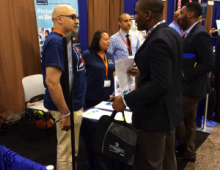In mBio, JGI researchers reported on microbial community composition and carbon emissions patterns from restored wetlands.
Promoting Safety & Wellness at Work and at Home
Marking its 9th year, the annual JGI Safety and Wellness Fair took place on Wednesday, June 3, 2015, drawing around 120 attendees to our Courtyard. Over a dozen booths promoted various aspects of health and safety, both at work and at home. The JGI Safety & Wellness (SWELL) Team, a group of employees who have…
Meraculous: Genome Assembly from Months to Minutes
“Using the parallelized version of Meraculous, we can now assemble the entire human genome in about eight minutes using 15,360 computer processor cores. With this tool, we estimate that the output from the world’s biomedical sequencing capacity could be assembled using just a portion of NERSC’s Edison supercomputer,” says Evangelos Georganas, a UC Berkeley graduate…
The Most Complete Functional Map of an Entire Enzyme Family
DOE-funded researchers develop a new process for annotating cellulose-degrading enzymes. The Science: Researchers at two Department of Energy-funded Scientific User Facilities collaborated with one of three Bioenergy Research Centers to develop and analyze high-resolution crystal structures of an enzyme from the cellulose-degrading GH55 family. They then went further and were able to apply a variety…
Jillian Banfield, University of California, Berkeley
Jillian Banfield, PhD is a prominent geomicrobiologist and biochemist, a UC Berkeley Professor, a Berkeley Lab Earth Sciences Division staff scientist, and a long time user of the DOE Joint Genome Institute’s resources through the Community Science Program (CSP) and the Emerging Technologies Opportunities Program (ETOP). In this short interview, Jill shares her perspective how…
Understanding the [Non-Coding] Spaces Between
DOE JGI researchers sequenced and analyzed a cyanobacterium with known nitrogen-fixing capabilities. The Science: Researchers sequenced and analyzed the uncommonly large genome of a nitrogen-fixing cyanobacterial strain, comparing it to the more than 150 extant cyanobacterial genomes. The Impact: Unlike many of the existing cyanobacterial genome sequences, the genome of Trichodesmium erythaeum IMS 101 is…
Launching the JGI Diversity & Inclusion Initiative
On April 3, 2015, JGI and Genomics Division supervisors took part in a half-day retreat on diversity & inclusion. “About 50 supervisors from Genomics and the Joint Genome Institute (JGI) gathered earlier this month at the retreat for talks and discussions on implicit biases, what an inclusive workplace looks like, how to implement processes in recruiting…
Big Plant Genomes: Formerly Intractable, No Longer Insurmountable
DOE JGI researchers have developed an assembly and mapping strategy for any species, including large and complex genomes. The Science: Through a combination of high-throughput sequencing, high performance computing, and genetic mapping, DOE JGI researchers have derived a sequence assembly for the highly repetitive plant genome of bread wheat (Triticum aestivum). The Impact: The researchers…
Soil bacteria and Setaria in R&D Magazine
“Our results show that healthy growth can be achieved by combining certain soil bacteria with grasses, even when plants are grown in extremely nitrogen-deprived soil,” said study coauthor Richard Ferrieri, director of Brookhaven Lab’s Radiochemistry and Biological Imaging Program. “We plan to apply this method to other crop systems, including bioenergy grasses like sorghum, switchgrass,…
A science ambassador at the NSBE Convention
As part of Berkeley Lab Director Paul Alivisatos’ Diversity & Inclusion Initiative, our own Steve Wilson served as a Lab science ambassador to the National Society of Black Engineers’ (NSBE) 41st Annual Convention on March 25-29, 2015 in Anaheim, CA. Wilson was part of a delegation including representatives from the Workforce Development & Education and Human Resources…


